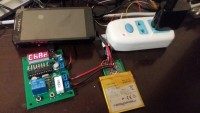Test bench for battery inside an equipment:

I build this bench 2 years ago. I wanted to know if my device (a mobile phone) was charging well the battery.So, I took a standard battery, connect to the phone through the board, and remote the 220V of the charger linked to the phone.With a 16F876A, it is possible to:- Connect or stop the charger (with a modified plug with relay inside)
I build this bench 2 years ago. I wanted to know if my device (a mobile phone) was charging well the battery.
So, I took a standard battery, connect to the phone through the board, and remote the 220V of the charger linked to the phone.
With a 16F876A, it is possible to:
- Connect or stop the charger (with a modified plug with relay inside)
- Connect a high power resistance to drain the battery
- Measure the current with an IC current sensor
- Measure the voltage of the battery The board is using a 4 digits 7 segments display, 2 button for the MMI.
Then, all is inside the SW. So far, the this board, I use MicroBasic (for the solar camera it is the MicroC).
2 applications are already developed:
Capacity charged by a phone:
1) Charging the battery through the phone with the standard charger
2) After enough time, stop to charge and connect the power resistor until the battery is at low level. Measure every sec the current then display the capacity
3) Go back to the step one. Can add some events like incoming call, SMS and so.
Charging capability at low battery level:
1) Discharging the battery until very low level (2.8V) with the power resistor
2) Connect the charger and monitor the battery voltage
3) if the battery voltage stick to a fix value, there is an issue (charger current is too low, or the device is consuming too much)
4) when the battery is at 4V, stop charging and increase the low level by 0.1V
5) Go back to step 1 until the low level is same than full charge level
Several other applications are possible with this board. And some evolution are planned such as random switch on of the device during the charging, monitor the charging and discharging current (need 2 current sensors).
Laurent




Discussion (1 commentaire(s))
Julius Caesar il y a 10 ans